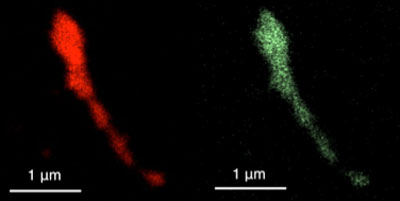Nanowerk November 27, 2018
An international team of researchers (USA – MIT, Singapore) controlled the morphology, composition, and functionality of Segregating-binary-alloy-type germanium–tin oxide systems using template-driven nucleation that leverages the electrostatic-binding specificity of the M13 bacteriophage surface. A wire like phase-change materials (PCM) was achieved, with controllable and reliable phase-changing signatures, capable of tens of nanoseconds switching times. This approach addresses some of the critical material compositional and structural constraints that currently diminish the utility of PCMs in universal memory systems…read more. Open Access TECHNICAL ARTICLE

Energy dispersive X-ray spectroscopy images of the sample of a solution with virus. Color coding of atomic species: germanium, red; tin, green. (Image: Singapore University of Technology and Design)